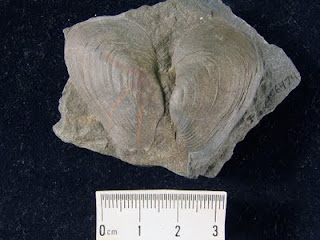What are the differences between brachiopods and bivalves, and how do you tell them apart?
The first thing one might notice if looking at them from a taxonomic viewpoint is that they belong in different phyla. Brachiopods are in the phylum Brachiopoda while bivalves are in the phylum Mollusca. This means that bivalves are related to the other molluscs (snails, cuttlefish, squids, nautiloids, octopus, etc.) while brachiopods are related to... brachiopods.
So taxonomically things are looking pretty distinct. On to the insides!
Both brachiopods and bivalves have two major muscles within the shell to keep it closed. Brachiopods have what are called adductor muscles. These muscles contract to keep the two valves closed. Bivalves also have adductor muscles that contract to keep the valves closed. So why do I bring this up as a difference? Bivalves have a second structure that separates them from the brachiopods. This structure is a ligament that joins the valves dorsally. When the adductor muscles in a bivalve relax, the ligament forces the two valves (shells) open. This is why bivalve shells (of dead bivalves) are often found in a "butterfly pattern" where both valves have opened in a pattern reminiscent of butterfly wings.
 |
| Modiomorpha (bivalve) specimen from our collection |
The absence of a ligament like this in brachiopods means that when brachiopod shells (of dead brachiopods) are found, both valves are often found closed up as though the animal were still alive.
 |
| Laqueus (brachiopod) specimen from our collection |
 |
| Borrowed from Dr. Dirnberger's site |
Feeding systems are also completely different between the two groups. Brachiopods feed by means of a lophophore. This structure has a series of ciliated tentacles that can be extended to create a current which allows the brachiopod to catch food particles from seawater.
Bivalves, on the other hand, use an inhalant siphon to gather food. Some bivalves extend the tip of this siphon over the seafloor to search for food. Many others use the inhalant siphon to draw seawater into the shell. This water is then sieved by the ctenidia, and small food particles are collected. There is even a small group of bivalves (Poromyacea) that trap small worms and crustaceans in their mantle cavity to be digested! In this photo from Friday Harbor, WA the longer siphon is the inhalant siphon (the other is the exhalant siphon).
 |
| Borrowed from a Friday Harbor blog |
Next week, external morphological differences!


ReplyDeleteMollusk Animal Images